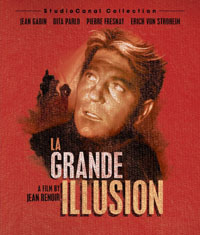 LA GRANDE ILLUSION
LA GRANDE ILLUSION
(not rated)
MOVIE: **** (out of 5)
BLU-RAY EXPERIENCE: **** (out of 5)
STARRING
Jean Gabin as LIEUTENANT MARECHAL
Marcel Dalio as LIEUTENANT ROSENTHAL
Pierre Fresnay as CAPTAIN DE BOELDIEU
Erich von Stroheim as RAUFFENSTEIN
Dita Parlo as ELSA
Studio: Lionsgate
Directed by: Jean Renoir
BY KEVIN CARR
I’ve said this many times in the past that one of the elements that I treasure most about writing reviews for DVDs and Blu-rays is that it affords me the chance to see movies that I have missed for one reason or another. This doesn’t just hold for movies I missed three months prior in the theater, but rather especially for classic films and foreign movies of note. Think of it as giving me a chance to be well read, from a cinematic point of view.
“La Grande Illusion” is one of those movies I probably would not have sought out to see on my own. It’s an older film that, while a classic, isn’t topping too many lists of must-see movies nowadays. More over, it’s a foreign film in multiple languages, which requires going to that section of a video store (which I sheepishly admit I don’t often frequent). Now that it’s gotten a full Blu-ray release, I’ve had a chance to see the movie for the first time and enrich my cinematic experience.
The movie follows a group of French soldiers in a German prison camp during World War I. They deal with the day-to-day living in the prison camp, often acknowledging their status in society and how it will be affected after the war is over. They attempt to escape, but when they are moved from camp to camp, the plans must be postponed. “La Grande Illusion” is seen as a powerful anti-war film, often contrasted to “All Quiet on the Western Front” which has a similar message but told with a very different perspective.
After nearly 80 years of war movies under our belts, it’s strange to look back at “La Grande Illusion” and view it as it was in its contemporary setting, which was before the escalation of World War II. It gives a starkly different view of the German military, which is hard to do under the yoke of the memory of the Nazis. But here, “La Grande Illusions” paints a more civilized version of war time. In fact, it almost paints too rosy of a picture, with killing in the line of duty done only under great duress and full respect given among borders.
The takeaway of this movie in a modern sense is to dig past the strange point-of-view of the prison structure and look at how society sees times changing. A big theme in this movie is how the bourgeoisie exist above the proletariat, to borrow some labels from Marxism. Here, the officers are shown as ultimately civilized and relating to each other. It doesn’t forbid them from mixing with the average joe in the prison camp, but it does put them on a different playing field.
“La Grande Illusion” reveals the view of the collapsing higher social class from within, and while there’s plenty of bourgeoisie and proletariat left in the world, it’s a different sort especially with America in a much more powerful position.
The biggest problems with this film is the rose-colored look at a German prison camp, which at times feels more like summer camp. While it was based on director Jean Renoir’s experiences, this becomes a bit much when the prisoners are given so much freedom and accoutrements.
The message is still clear, that accomplishments via war are the grand illusion when put against the human condition. It’s not a flag waver for any country, but rather an introspective look at how the world is changing and whether war can solve anything. Again, this makes more sense looking back at World War I as opposed to pushing back the foreign aggression of German, Italy and Japan during World War II.
But don’t let the way the world has changed since the movie was released change your desire to see it. “La Grande Illusion” is available on Blu-ray, looking quite crisp and clean from the Studio Canal Collection.
The Blu-ray includes featurette about the success and controversy of the film, a look at the film by professor and critic Ginette Vincendeau, a look at the recover of the original negative and how the film was restored. There’s also a John Truby film presentation and trailers from the releases in 1937 and 1958.
